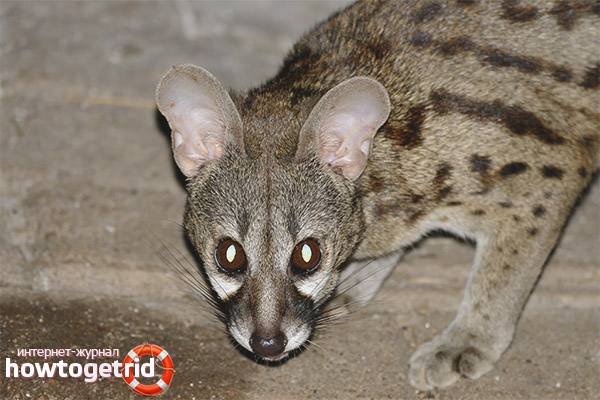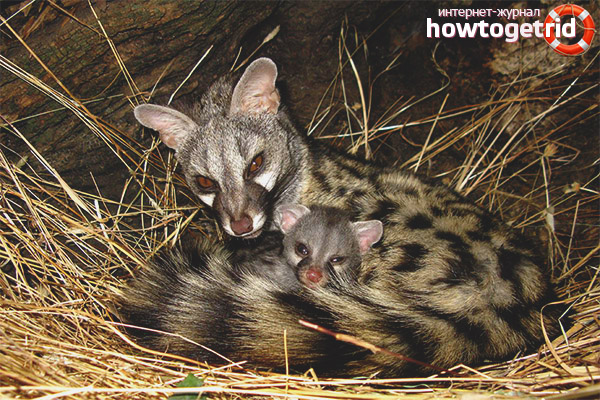The content of the article
Genetta is a deft small animal of medium size, habits and looks like a cat. Belongs to the family of wyverns.
Features of the animal, varieties
It is believed that this animal is one of the oldest mammals. Even in ancient Greece they were kept as pets and used to fight rodents. However, evolution did not affect them in any way. The body structure of the animal is very harmonious, reaches a length of up to 60 cm. The height at the withers reaches 20 cm.
Its weight does not exceed 2 kg. The legs are small, the tail is up to 60 cm long and very fluffy. The muzzle of geneti is small, but rather long and a bit pungent. Large ears are located on it. The pupils of the eyes narrow in the daytime and form fissures similar to those of cats.
Since the genet is a predator, it has a set of razor-sharp teeth, in all - 40 pieces. Claws, like cats, can be pulled into the pillow and, in fact, not large. There are five fingers on the animal’s paw. This also applies to the hind and forelimbs. The structure of the fur is soft and pleasant when touched. The color of the animals depends on their subspecies and is slightly different. These differences are quite noticeable upon closer examination.
- Geneta vulgaris has a light gray fur, smoothly turning into beige. On the sides are strips of black large dots, the muzzle is dark with a lightish strip located above the nose and small spots close to the eye. The muzzle on the tip is white. The tail is striped with eight white rings, a black tip.
- The spotted geneta is light gray in color and has a spotted color, but is distinguished by a black narrow strip running along the entire ridge.
- Tiger geneta is distinguished by a light yellow color on top of the back, which gradually turns into gray. The tail has light stripes, alternating with darker ones and ending with a completely black tip.
- The lightest color has the Ethiopian genet. The back and sides of the animal shimmer from white to yellow, the tummy is gray. There are five bands on the back, and two more in the occipital region. The tail is no different from the tail of relatives.
Habitat
The birthplace of genetics is Africa, its northern coast. At the moment, the animal has spread over fairly large distances. Their habitat includes the states of the Arabian Peninsula and the southern part of Europe. Most often they can be seen in France and Spain.
They live wherever there is food suitable for them. But preference is given to a wooded area, not far from freshwater bodies of water. However, they easily take root both in the mountains and on the plains. This is a very clever animal, which, using short legs, spreads above the ground between stones and branches at the speed of a lizard. He likes to live near people where he does not hesitate to eat poultry.
Genetics lifestyle, features of her character
Genetta is essentially a loner, but occasionally an Ethiopian species can settle in a pair. The area controlled by one male is no more than 7 kilometers. He marks it with his musky secretions, as well as feces. It is interesting that the secretion of their musk glands found their application in perfumery, and this is one of the reasons for hunting them. Leads a predominantly active nightlife.
Favorite places of resettlement are crevices of trees, burrows abandoned by other animals or cozy places in stones where the animal is covered in the afternoon, curled up in a ball. The animal is able to seep into the smallest holes, enough for the head to go there.
If the animal feels a sense of anxiety or threat, his hair immediately becomes sticky, and he immediately rushes to the source of the threat, bites him, scratches and attacks with a stream of odorous musky liquid. This feature makes it similar to a skunk.
There was a time when in the Middle Ages they performed the functions of pets, but cats took their primacy. Although now in African countries they are often kept for rodent hunting. They say that in a fairly short time they are able to completely rid the house of rats and mice.
In the form of pets, genet is also used in both European and North American countries. The animal is tamed, and can easily make friends with a person. The similarity with the cat is obvious - the genet gets used to the name given to him, responds, follows the owner and allows himself to be stroked and scratched. In a cozy home environment, when there is no element of threat, genets are absolutely clean and do not emit extraneous odors at all. Like cats, they quickly get used to the tray. Often the owners remove the claws of the animal and sterilize. It is not difficult to acquire a genet, but do not forget that it needs special attention.
Nutrition
They are active at night. During the day, they are usually found in crevices and ravines, burrows dug by other animals, in tree voids or on large tree branches. They are able to climb trees, hunting for nesting or resting birds, but most of their food runs or crawls on the ground, and the geneta prefers to hunt on the ground. They are quiet and silent. In pursuit of the victim, they fall to the ground and seem to glide along it. At the same time, their body seems longer. They imperceptibly approach their victim and make a lightning-fast jump. There is a capture of prey by the throat and strangulation of it.
At night, they hunt for rodents, various lizards, large insects and even birds. Sometimes they can enjoy even small animals not exceeding the size of a hare. Occasionally they eat fish, and even less often carrion. They can cleverly climb a tree in search of ripe fruit. The slenderness of the body allows genetics to seep into the hole where the head is able to crawl. Living near a person, they regularly raid poultry farms (chickens, geese, pigeons).
Breeding
Genets in the mating season are combined in pairs. This process is year-round, and occurs in different months - it depends on the habitat. The puberty of the animal occurs at the age of 2 years. The male senses the female, and searches for her. Mating itself does not last long, no more than 10 minutes, however, in anticipation of this, the mating game can last up to two hours.
Bearing lasts about 70 days. On the eve of childbirth, the female builds and ennobles herself a nest in the grass. One litter counts from one to four babies, usually two to three. Newborns at first are blind, deaf and without hairline. The weight of newborns is 60-80 grams. Only on day 10, the ears of the cubs rise and the eyes open. The first two months of their life, they feed on mother’s milk, but they also eat regular food, starting from the second month of life. Eight months later, young genetics are adapted to independent life, but they continue to live on the territory of the mother. During the year, the female is able to give birth twice.
Home Content
Oddly enough, but genetics in everyday life are quite unpretentious, although they require constant attention. Only a few simple rules should be followed. The main thing is to feed correctly and regularly, as well as to clean them regularly.
Content Tips:
- Personal space.In its behavior, the animal is very similar to a domestic cat. He will be happy to sleep on the couch or in the chair. If he gets a "cat house", then he will gladly use it. The only thing to consider is the size of the animal. Need a house more quickly.
- Animal hygiene. Geneta is naturally clean. She regularly cares for herself, combing. If the animal is in a good mood, it will not refuse the help of the owner, and it can be combed out with a special brush. At the same time, it can feel pleasure and express it with a happy rumbling. However, you do not need to insist if the geneta is "not in the mood." As for the toilet procedures, then everything happens like in cats. The animal, even in the wild, walks according to needs in one place. So it will be easy to walk into the tray. It also learns very quickly. However, you must ensure that the tray is always clean. These necks may refuse to go there a second time if not cleaned there.
- Nutrition. Here, too, everything is simple. As a main dish, cat food is perfect. However, nutrition should be balanced and varied. Therefore, periodically, the pet should receive meat, fish and fruit. They are also very pleased with live rodents.
- Precautionary measures. When feeding an animal with raw cape and fish, one must not forget about the prevention of worms.
Life expectancy, enemies
The animal has not many natural enemies. Basically, these are large cat predators, birds, snakes, wild dogs. However, genetics are very fast animals, and catching and catching them in the wild is not easy.
The destruction of genetics by people is due to meat and pleasant fur, however, not at the commercial level. It is not uncommon that they are simply shot near the houses to stop their raids there. The geneta population is quite numerous and the danger of the extermination of the animal does not exist. According to the International Union for Conservation of Nature, this species is classified as the “least worrisome”.
Video: Genetta












Submit